Abstract
The present study is part of a more ample research which will be presented within the PhD thesis The influence of the non-formal education upon the young pupil in formal educational contexts, made at the Doctoral School: Education, Reflection, Development – the Faculty of Psychology and Educational Sciences, Babeş-Bolyai University Cluj-Napoca. Hereinafter, we would like to show to what extent the scouting activities, based on the scout method, have a significant positive influence over the school integration of the pupils from the primary grades into their own class. The applicative pedagogic research unfolds for a year and a half, following the students from the preparatory grade to the end of the first grade. In the study five classes, out of which 41 pupils enlisted at the scouts, are involved, constituting the experimental sample, and their colleagues, 95, representing the control sample. The scouts participated to weekly meetings and to outdoor activities which prove their efficiency according to the socio metric index calculated on the basis of the socio metric test. A matrix was made for each class because the students from both samples did not interact with each other. For each student, the sociometric status was calculated based on the choices and the rejections of his classmates.
Keywords: Scouting activitiesthe scout methodschool integrationyoung pupilssocio metric index
Introduction
Presently, ONCR (Romania's Scouts National Organisation) is conducting nationally and locally numerous activities in various areas: training sessions, activities for developing life skills, activities for integrating people with special needs, charity activities, ecological activities, civic education, environmental education, vocational training, seminars, workshops, publications (magazines, leaflets, and brochures), national and international camps, youth exchange programs, fund raisings and many other activities.
The activity on a local level, for this study, was made taking into consideration:
Problem Statement
The World Organisation of Scouting Movement (WOSM) is a global movement, non-governmental and non-profit with over 30 million members from 216 countries and territories, where it is enlisted as a founding member. “Romania's Scouts” National Organisation, which in turn is formed by local centres among which there is the Local Centre Tîrgu Mureș. The latter respects the operating structure of a national Scouts organisation, having an educational offer throughout 16 years (from 5 to 21 years old) based on a non-formal curriculum adapted to each age group (www.scoutmures.ro). In the present study we will refer to the cubs’ age group, meaning children from 6 to 10 years old.
Research Questions
The fact that the three forms of education potentiate each other with the purpose of ensuring the individual an active insertion in society is known. But how much can the non-formal education intensify the effects of the formal education? We took into consideration scouting, as an example of non-formal education, and we analysed its influence over the primary pupils' school integration.
Purpose of the Study
Through this research study, we wanted to find out to what degree scouting activities have a positive, significant impact upon school integration. We have followed 136 pupils from the preparatory grade to the end of the first grade. The children from the experimental sample participated at the meetings and scouting activities for 19 months.
Research Methods
The purpose of the present study is to establish in what way the activities based on the scout method have a significant positive influence over the school integration of pupils from the primary grades into their own class.
Scouting targets more areas of development among which the area of social development, where there is strong emphasis on: communication, interaction with other people and respecting the rules of each context. Therefore we considered that the activities based on the scout method will have a positive influence over one of the challenges that young pupils deal with, and that is integrating within a new group and following new rules specific to the formal context. The
In order to follow
The psycho- pedagogic experiment
The psycho- pedagogic experiment
The
The participants' sample
After the presentations made to the parents, a number of 41 students were enlisted at the scouts, from five classes, which constituted the experimental group and the other 95 classmates formed the control group (Table
The pupils enlisted at the scouts joined, within “Romania's Scouts” National Organisation – The Local Centre Tîrgu Mureș, the children who were already members of the organisation. We consider this aspect beneficial, as one of the scouting principles is „the big one helps the small one”, where „the big one” can also be the one with some experience in scouting, it is not necessarily about age.
The content sample
The symbolic frame that dresses the scouting pedagogy, for the cubs' group age, is The Jungle Book by Rudyard Kipling. Through the symbolic frame a series of development areas are targeted, each associated to one character from the story. The areas of development are done gradually, during the 4 years dedicated to this age branch, the children being aware that they are in the territory of the character that rules the respective development area.
For the present study we started from the Enlisting period, meetings with parents and activities specific for the entrance of the cubs within Haitic and of adjustment, then three areas of development were followed (the social development area - Chill's territory, the intellectual development area - Baloo's territory and the emotional development area - Kaa's territory). All the meetings and the activities that were projected and developed as a formative experiment for this study are described in detail in Guide for meeting and scouting activities. Age group 7-10 years ( Moldovan, & Bocoș, 2017).
The stages of the pedagogic research
According to the specific of the psycho-pedagogic experiment, there are three stages described the present research: the pre-experimental stage, the formative experimental stage, and the post-experimental stage.
The data obtained as a result of the socio-metric test's application were analysed through the socio-metric matrix, the data of the socio-metric test being registered into a table with a double entrance, where both horizontally and vertically the pupils are registered. For each class there was a matrix made, so that the students of the two samples did not interact, therefore, they do not know each other. For each student it was written down the selection (+) or the rejection (-) of the classmates, making a total (following the vertical of the matrix) of both the selections and the rejections. Having the data of the socio-metric test written down in the matrix the index of the socio-metric status was calculated. This socio-metric index reveals the position occupied by the student within the class and it is calculated following the formula: I = n/(N-1) where n represents the number of selections received by the student, and N represents the number of the group members (the class):
In order to be able to compare the two samples, considering that the number of students is different, we have calculated what percentage of the students from the experimental group is popular, accepted, indifferent or marginalized and how many of the students from the control group are popular, accepted, indifferent or marginalized.
Findings
The next table shows the percentages obtained by the two samples during the
We can notice that the percentages of the accepted and indifferent values are only with one percentage higher than those from the control sample, but in terms of popular and marginalized values, the extremes of the groups, the differences are much bigger between the two samples. The percentage of the popular value is higher in the case of the experimental sample than the percentage of those from the control sample, and in the case of the marginalized students the percentage is reversed, still in favour of the experimental sample. Figure
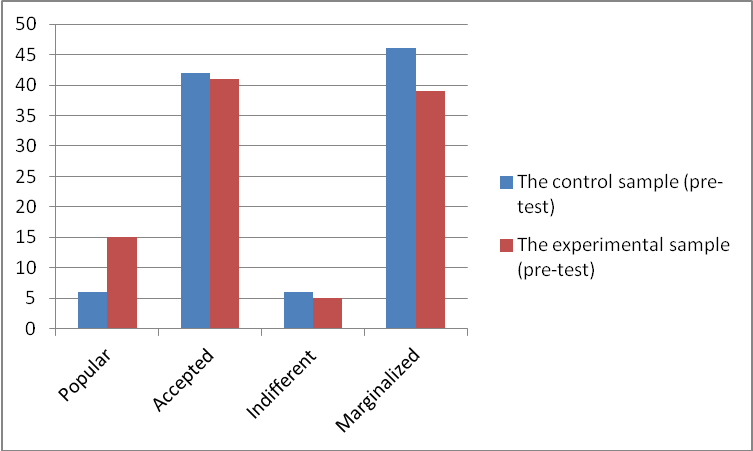
In Table
We can notice that in the case of the intermediary evaluation 1 the percentages are not as similar as they were in the pre-test, but significant differences between the two samples have started to appear. If in the case of the experimental sample the highest percentage, of 59%, represents that of the accepted students, while in the control sample the percentage of 52%, the highest, represents the marginalized students. The percentage of the popular students in the experimental sample is more than twice as high as the one in the control sample (14% versus 6%).
We can also notice at the second intermediary evaluation that the percentage of the accepted students in the case of the experimental sample is the same as the percentage of the marginalized ones in the control sample. The percentage of the popular ones increased significantly in the case of the experimental sample reaching a percentage of 32% from the total of the students who participated in the intervention programme – meetings and scouting activities.
We have made Figure no. 2 in order to also compare graphically the two samples at the intermediary evaluation 1 and Figure no. 3 in order to highlight the results from the intermediary evaluation 2:
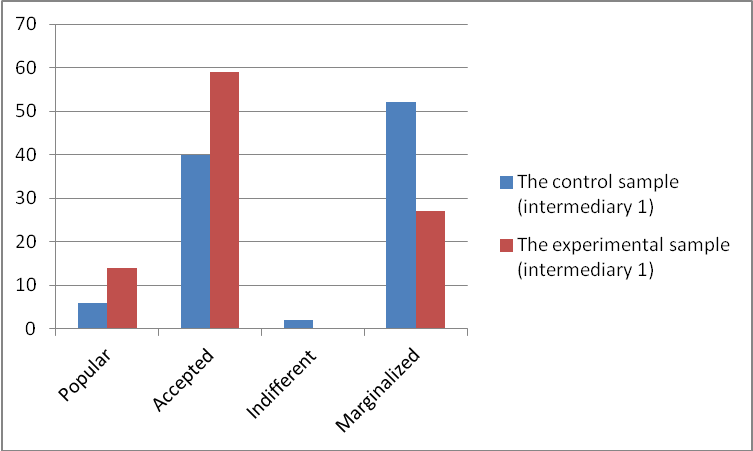
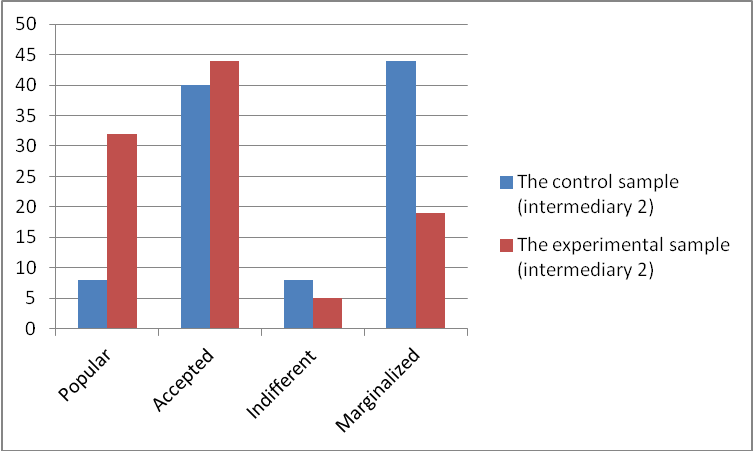
After the formative experiment's stage there was an evaluation called post-test in order to see the changes that resulted after the participation of the experimental sample to the scouting activities.
The next table shows the percentages obtained after the calculation of the socio-metric index for each student from the two samples:
If in the case of the experimental sample the highest percentages were for the popular and accepted students (42%, and 46%), in the control sample the highest percentages are for the marginalized and accepted students (51%, and 42%). The number of students from the experimental sample who are marginalised by their classmates has decreased considerably, reaching 7% from the total of students who are a part of this sample. In Figure
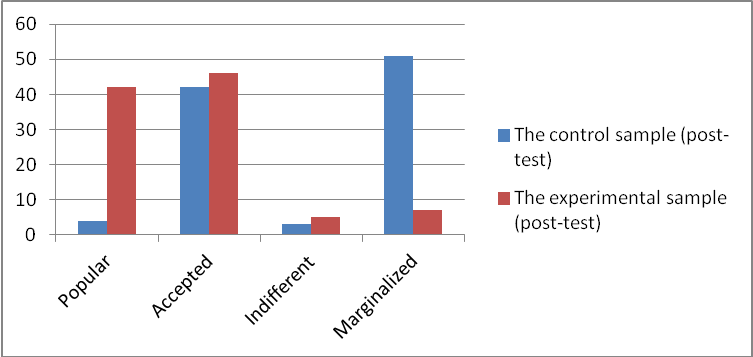
The post-test evaluation was made at a distance of 18 months from the first evaluation. Further, we will present the evolution of the two samples by comparing the four evaluations. For the control sample we have made Table no. 5, where we compared the percentages of the preferential psycho-social values:
These percentages can be better noticed, for each evaluation, in the next figure:
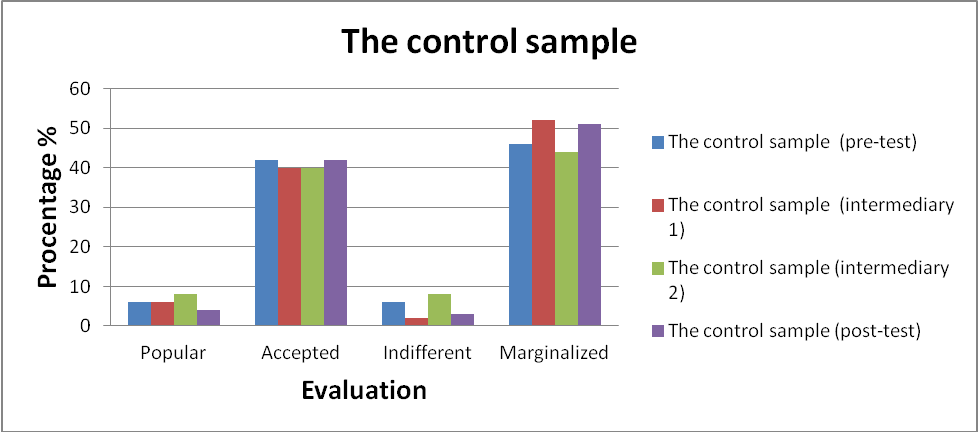
Following Table
For the experimental sample we have made Table
These percentages can be better noticed, for each evaluation, in the following figure:
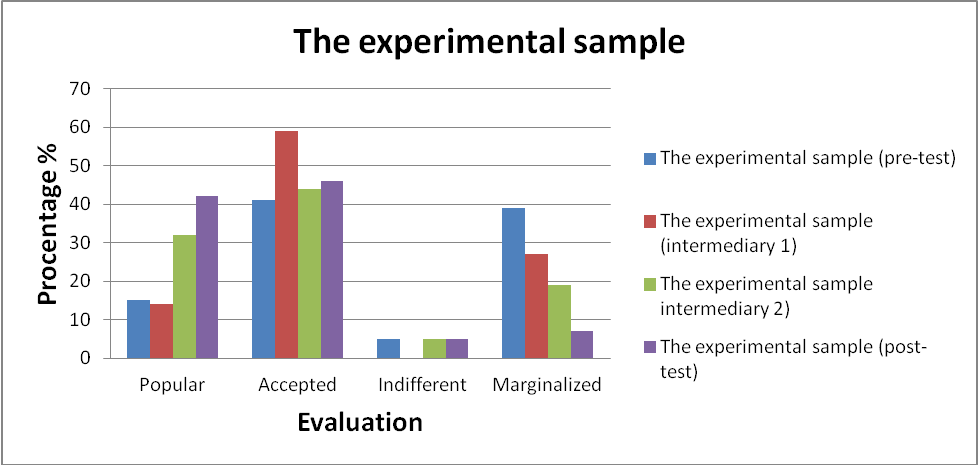
By analysing Table
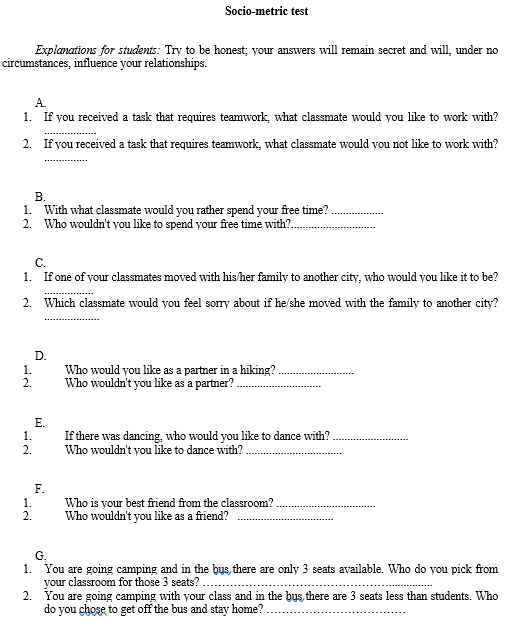
Conclusion
This study contributes to the highlight of the positive effects that scouting has over young pupils regarding school integration. By testing the research's hypothesis we have found out that non-formal scouting educational activities determine significant modifications to the degree of pupils' integration within the class they are a part of.
The results obtained through the socio-metric test have highlighted that fact that the students from the control sample maintain their status in their classes and implicitly the degree of integration in the school environment throughout the entire research. While the experimental sample changes its composition, the students modify their status in the classes they come from, all along the research. These results highlight the increase of the degree of school integration, more precisely into the class group for those who participate at the non-formal scouting activities.
References
- Moldovan, O., Bocoș, M. (2017), Guide for meetings and scouting activities. Age group 7-10 years, Tîrgu Mureș
- Moldovan, O., Bocoş, M. (2016), The influence of scouting activities upon the students’ school performance. Analysis for Mathematics and the environment exploration and Communication in the Romanian language, in Education 21 Journal 14.
- Petrea, E. (coord.) (2010), The cubs' leader's guide, The manual's editor: “Romania's Scouts” National Organisation, Bucharest.
- Retrieved from: www.scout.ro – accessed at 15.05.2017
- Retrieved from: www.scoutmures.ro - accessed at 10.05.2017
Copyright information

This work is licensed under a Creative Commons Attribution-NonCommercial-NoDerivatives 4.0 International License.
About this article
Publication Date
28 June 2018
Article Doi
eBook ISBN
978-1-80296-040-2
Publisher
Future Academy
Volume
41
Print ISBN (optional)
-
Edition Number
1st Edition
Pages
1-889
Subjects
Teacher, teacher training, teaching skills, teaching techniques, special education, children with special needs
Cite this article as:
Moldovan, V. -. O., & Bocoş-Binţinţan, M. (2018). Scouting Influence Upon The Young Pupil’s Integration Within Formal Educational Contexts. In V. Chis, & I. Albulescu (Eds.), Education, Reflection, Development – ERD 2017, vol 41. European Proceedings of Social and Behavioural Sciences (pp. 69-80). Future Academy. https://doi.org/10.15405/epsbs.2018.06.8

